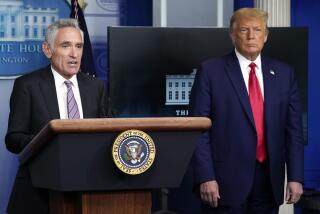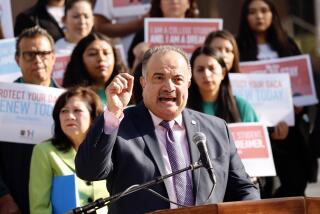Stanford Will Make Effort to Oust Director of Think Tank
SAN FRANCISCO — Stanford University’s Board of Trustees announced Tuesday that it plans to replace W. Glenn Campbell, the combative director of the Hoover Institution.
The action was the latest and potentially most divisive episode between the school and the think tank, members of which have been key advisers to President Reagan.
Campbell, who has directed the institution on the Stanford campus for 28 years and is a friend of the President, has vowed to fight any effort to replace him before his planned retirement in 1994. As recently as last month, he threatened that Stanford would be “slapped, one way or another, with a lawsuit” if the university tried to force him from the office once occupied by the late President Herbert Hoover.
“Now if they want nationwide notoriety, the university we love, just do that, because I can assure you that the fellow sitting here tonight comes from a warrior tradition,” Campbell told a gathering of campus Republicans last month.
Tuesday’s announcement is another twist in the university’s long-standing feud with Campbell over the think tank’s reputation for conservative thought. Liberal faculty members have complained of the institution’s presence on the campus, and the dispute flared up last year over Campbell’s efforts to bring the Reagan Library to Stanford. The plan met with disdain by faculty members who feared it would damage the university’s reputation, and the archives are to be located in Ventura County.
In a letter to Hoover’s oversight committee, Warren Christopher, president of the Stanford University trustees, said the university plans to replace Campbell in August when he turns 65.
Christopher said in the letter that the university would buy out Campbell, whose post is untenured, with a “generous salary with annual increases,” travel and health benefits, enhanced retirement pay and a title--senior fellow and director emeritus.
But some faculty members who have been critical of Campbell say the move reflects concern over divisiveness between the institution and the university. The decision on Campbell comes as a group of Stanford faculty members is demanding that Stanford bring Hoover under its direct control or sever all ties with it.
In a press release, the university said it will begin a search for Campbell’s replacement.
Prominent Location
The Hoover Institution of War, Revolution and Peace occupies the Hoover Tower, the university’s most prominent symbol, and surrounding buildings. Relations between Campbell and Stanford President Donald Kennedy are said to have deteriorated to the point where the two communicate only through memos. The only control Kennedy and the Board of Trustees have over the think tank is the right to hire the director and set the salary.
Campbell has complained that his $106,000 annual salary is low and that university officials have held down his pay in the hope that he would resign. But while the money might serve as an enticement, Campbell has vowed to stay on the job until 1994.
In a statement Tuesday, Campbell said he learned of the latest plan in a meeting with Christopher on Tuesday, adding: “In the course of a lengthy career, I found it is a mistake to react immediately and publicly to a surprise proposal.”
Campbell’s statement pointed out that Christopher’s letter to the Hoover Board of Overseers praised him for developing the institution, and said he was “interested to learn that the Stanford trustees hold the Hoover Institution in high esteem.”
Neither Kennedy nor Christopher could be reached Tuesday for comment.
Director’s Authority
Campbell has the authority to select Hoover’s fellows, none of whom have tenure, and to reappoint them. The scholars, some of the most preeminent thinkers in the country, are free to write books and research topics of interest. They are given offices and access to the impressive Hoover library and archives, which contain 30 million items. The institution offers no degrees and has no students.
Stanford political scientist John Manley, a critic of the institution, pointed out that at least 50 Hoover Fellows have served as presidential advisers in the Reagan Administration.
Current fellows include economist Milton Friedman and physicist Edward Teller, a developer of the hydrogen bomb and advocate of the President’s Strategic Defense Initiative.
Campbell himself chairs the President’s Intelligence Oversight Board and is a member of the Foreign Intelligence Advisory Board. He was instrumental in initially persuading Reagan to locate his presidential library in the foothills behind Stanford.
‘National Treasure’
The President praised Campbell earlier this year, and said the Hoover Institution’s “bold intellectual leadership has made it not only an institution with an international reputation but also a national treasure.”
Manley noted that Campbell “sets the tone” and raises money for the institution, which is endowed with assets of as much as $300 million. But he also said that in their effort to remove Campbell, the trustees seem to be reaffirming that the institution will remain autonomous.
“They have failed to face up to the problem,” he added. “ . . . No self-respecting university can house an independent, politically active think tank and no other university does house one.”
The current arrangement between Stanford and the institution was forged in 1959, when Herbert Hoover wrested control of the institution from liberals and helped install Campbell as director. At the time, Manley said, Hoover stated its mission as that of exposing the evils of theories advanced by Karl Marx.
More to Read
Sign up for Essential California
The most important California stories and recommendations in your inbox every morning.
You may occasionally receive promotional content from the Los Angeles Times.










